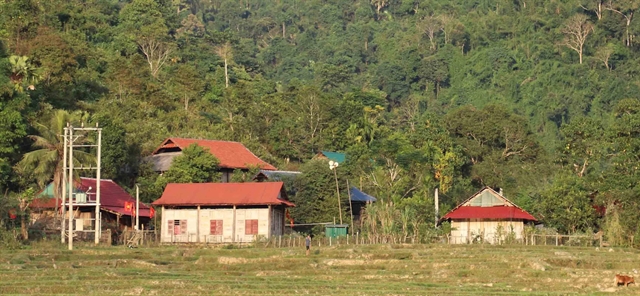 Society
Society

 |
| Spacious houses of ethnic Thái people in Na Kho Village, Nga My Commune, Tương Dương District in Nghệ An central province. — VNA/VNS Photo Xuân Tiến |
NGHỆ AN — Ethnic Thái people in Na Kho Village have together made great efforts in production to escape poverty and build an increasingly prosperous village.
Na Kho is one of nine villages in Nga My mountainous commune in Tương Dương District, the central province of Nghệ An.
It is isolated in the Pù Huống Nature Reserve, about 15km from the commune centre.
Ethnic Thái people settled and established a village here in 1946.
Vi Thị Mùi, Deputy Chairwoman of the Nga My Commune People's Committee, said the commune was a mountainous area more than 60km from the district centre.
The commune has more than 1,110 households, who are Kinh, Thái, Khơ Mú and Ơ Đu groups, of which the Thái ethnic group accounts for nearly 90 per cent.
They live along the Nậm Ngân and Nậm Kho streams.
Transport here is still very difficult. The rough dirt roads are dangerous, with many rock slides, and only offer access in dry season.
During the rainy season, people cannot travel because of high, fast flowing water in the Nậm Ngân and Nậm Kho streams.
From the gateway of Na Kho Village you can see the small but well-built houses of the Thái people clustered at the foot of the majestic limestone mountains.
After nearly 80 years, Na Kho Village has grown from just a few households to nearly 80, with more than 370 people.
Changes
According to head of the Na Kho Village Lữ Văn Uôn, to build the stable lives they have today, local people had to unite and be self-reliant in their work.
They built fish ponds and duck raising areas.
More than 20ha of terraced fields in the village always have enough water to grow two crops per year.
The forest in the village has been kept intact, thanks to the joint protection efforts of the community, and has become the pride of the local people.
With natural beauty, peaceful scenery, fresh and cool climate, the isolated forest promises an ideal sightseeing tourism destination in the future.
Van Văn Hoàn, 76, a local resident, said that right in this poor land, he made a fairly stable income by raising fish, pigs, buffaloes, ducks and chickens.
He also grows fruit trees and spices.
Warmth
Uôn said when he was young the people depended on nature, staying in the forest to find vegetables and fruits, and hunting small animals, but now the life of ethnic Thái people had changed.
Nearly 30 households had escaped from poverty.
The village had more than 120 buffalos, nearly 200 cows, goats and pigs, and thousands of poultry.
Ducks raised in Na Kho Village are famous not only in Nga My Commune, but also across Tương Dương District, for their deliciousness, according to the village head.
A major milestone for people in Na Kho Village was achieved in 2015 when the national power grid reached the village, realising their dream of many years.
They no longer have to light oil lamps or use water-powered electricity.
Electricity illuminates a vast area, creating conditions for people to access advances in science and technology in livestock production, improving people's knowledge and entertainment needs through watching television and listening to loudspeakers and radio.
The greatest joy of local people is that, since the primary school and kindergarten were established, all the children have learned to read and gone to class at the regulated age.
Education in Na Kho Village started in 1980, when teachers came here to build classrooms with wooden boards and roofs thatched with grass and palm leaves.
Generations of teachers have overcome deprivation and difficulties to teach here.
In 2001, new primary schools and kindergartens were built, solid and spacious.
With a stable life and a better economy, people in the village have focused on preserving traditional culture and eliminating bad customs.
Currently, ethnic Thái people still use their traditional costumes.
Cultural features in cuisine are still preserved through traditional dishes.
When Tết comes, people play gongs and drums, and play traditional folk games under the stilt houses.
Nga My Commune authorities said that in recent years, the commune had supported many models such as duck raising and growing medicinal plants.
In the future, when a bridge over the Nậm Kho Stream is completed, it will allow local people to travel smoothly, opening up great opportunities for them to further develop. — VNS




